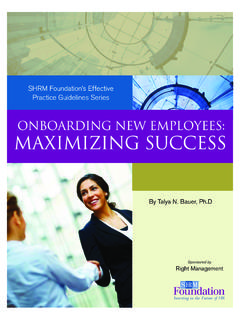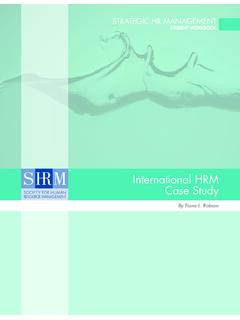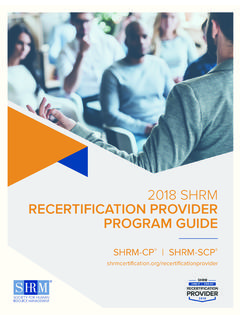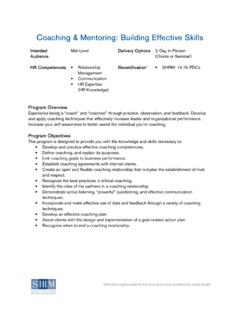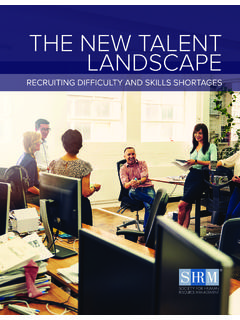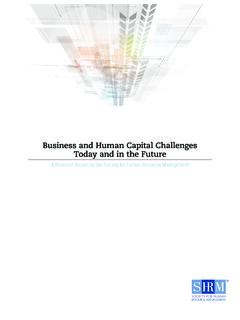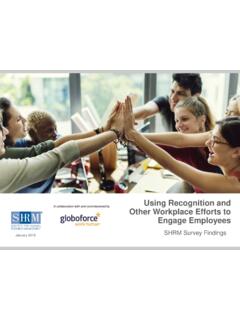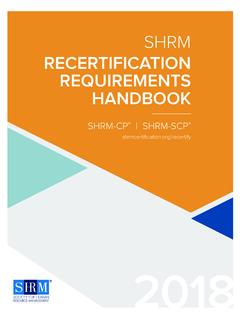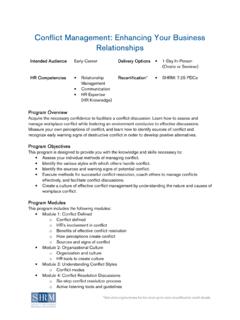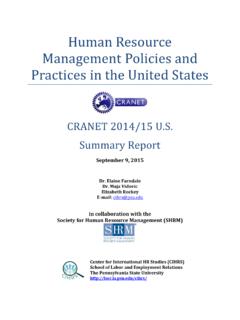Transcription of 2017 EMPLOYEE BENEFITS - SHRM
1 2017 EMPLOYEE BENEFITSREMAINING COMPETITIVE IN A CHALLENGING TALENT MARKETPLACE17-0428 The Society for Human Resource Management ( shrm ) is the world s largest HR professional society, representing 285,000 members in more than 165 countries. For nearly seven decades, the Society has been the leading provider of resources serving the needs of HR professionals and advancing the practice of human resource management. shrm has more than 575 affiliated chapters within the United States and subsidiary offices in China, India and United Arab Emirates. Visit us at EMPLOYEE BENEFITSR emaining Competitive in a Challenging Talent MarketplaceA RESEARCH REPORT BY THE SOCIETY FOR HUMAN RESOURCE MANAGEMENT Media Contact Kate Kennedy + Hill Online: Research & Surveys: Research on Twitter: @SHRM_ResearchSHRM Research on LinkedIn: Research on shrm Connect.
2 HeadquartersAlexandria, VA PlazaChaoyang DistrictBeijing, Sector 26 Haryana Arab Emirates Dubai Knowledge VillageDubai, BENEFITS Trends2 Why BENEFITS Are Important3 Cost of Benefits3 What Organizations Can Do to Leverage Benefits4 Health Care Benefits8 Wellness Benefits9 Paid Leave Benefits11 Retirement Savings and Planning Benefits12 Work-Life and Convenience Benefits13 Financial and career Benefits14 Travel and Relocation Benefits15 Conclusion16 Respondent Demographics18 Methodology19 Appendix: BENEFITS by Year19 Health, Leave and Retirement Benefits19 Table 3: Health-Related BENEFITS by Year20 Table 4: Coverage for Specific Health Services or Procedures by Year21 Table 5: Wellness BENEFITS by Year22 T able 6: Leave BENEFITS by Year23 Table 7: Retirement Savings and Planning BENEFITS by Year24 Work-Life and Convenience Benefits24 Table 8: Flexible Working BENEFITS by Year25 Table 9: Family-Friendly BENEFITS by Year26 Table 10: EMPLOYEE Programs and Services by Year27 Financial and career Benefits27 Table 11: Compensation BENEFITS by Year28 T able 12: Financial BENEFITS by Year29 Table 13.
3 Professional and career Development BENEFITS by Year30 Travel and Relocation Benefits30 Table 14: Business Travel BENEFITS by Year31 T able 15: Housing and Relocation BENEFITS by Year32 EndnotesTO REMAIN COMPETITIVE IN THE TALENTMARKETPLACE, 1/3 OF ORGANIZATIONS INCREASED THEIR OVERALL BENEFIT OFFERINGS IN THE LAST 12 COMPETITIVE IN A CHALLENGING TALENT MARKETPLACE | 1In January and February 2017, the Society for Human Resource Management ( shrm ) conducted its annual survey of employers to gather information on more than 300 EMPLOYEE BENEFITS . The survey asked human resource professionals if their organizations formally offered any of the listed BENEFITS to their employees.
4 This report examines the prevalence of BENEFITS over the past five years to track trends and understand the BENEFITS landscape in the current talent can use data in this report to help inform their BENEFITS strategy. In addition to a discussion of the key findings, tables listing the prevalence of BENEFITS over the past five years are included in the appendix. Customized reports are available through the shrm Benchmarking Service to provide organizations with BENEFITS data for their specific industry. OVERALL BENEFITS TRENDSRECRUITING DIFFICULTY HAS CONTINUED TO INCREASE OVER THE LAST FIVE YEARS, AND COMPETITION FOR TALENT IS TO ATTRACT AND RETAIN TOP TALENT, ORGANIZATIONS MUST LEVERAGE THE BENEFITS PACKAGE THEY OFFER TO THEIR ,500 or more employeesb 100 to 499 employeesNearly one-third of organizations increased their overall BENEFITS offerings in the last 12 months, with health (22%) and wellness (24%) BENEFITS being the most likely ones to experience growth (see Figure 1).
5 The top reason for increasing BENEFITS was to remain competitive in the talent marketplace. Given that two-thirds of organizations (68%) were experiencing recruiting difficulty and skills shortages for certain types of jobs in 2016, organizations need to focus on providing a competitive BENEFITS package to retain and attract top BENEFITS can be leveraged to help with common recruiting strategies, including increasing retention efforts, expanding training programs to help improve skills of new hires, using/enhancing an EMPLOYEE referral program, offering more flexible work arrangements, providing monetary incentives to candidates ( , signing bonus) and offering new job perks.
6 Of these strategies, HR professionals indicated that offering more flexible work arrangements was the most organizations (6%) had decreased BENEFITS overall. Large organizationsa (12%) were three times more likely than midsize organizationsb (4%) to have decreased overall BENEFITS offerings in the past 12 months. Most commonly, organizations had to decrease the level of BENEFITS to remain financially stable, whether it was due to increasing costs of BENEFITS , economic factors or poor organizational performance. Other organizations had experienced a merger or acquisition or had implemented other strategic changes to their organization or to their BENEFITS that had reduced their BENEFITS package were most likely to have decreased health care BENEFITS (57%).
7 Another one-quarter (24%) decreased wellness BENEFITS , though a small portion increased this benefit. Organizations could be adding wellness BENEFITS as a cost-reduction strategy or possibly to supplement the loss of health BENEFITS options with less costly BENEFITS . Other shrm research found that more than three-quarters (77%) of organizations indicated their wellness program was somewhat or very effective in reducing health care costs, and 88% rated their wellness initiatives as somewhat or very effective in improving employees Another interesting finding for this group of organizations was that 15% had increased flexible working BENEFITS , which could be another cost-effective way to enhance EMPLOYEE BENEFITS while going through difficult financial times or organizational organizations kept the same level of overall EMPLOYEE BENEFITS from 2016 to 2017.
8 Although they may have made changes to some BENEFITS that had little effect on the overall BENEFITS package. The most common changes for these organizations were to increase wellness BENEFITS (13%) and professional and career development BENEFITS (7%). Organizations aiming to attract younger generations may want to enhance career development and advancement opportunities because these BENEFITS are more important to Millennials, who are earlier in their careers, than to older TO REMAIN COMPETITIVE IN THE TALENT MARKETPLACE, 1/3 OF ORGANIZATIONS INCREASED THEIR OVERALL BENEFIT OFFERINGS IN THE LAST 12 1 ORGANIZATIONS WERE MOST LIKELY TO INCREASE WELLNESS AND HEALTH-RELATED BENEFITS Note: n = 1,318-2,591.
9 Respondents who answered N/A, did not offer in the past 12 months or not sure were excluded from this analysis. Percentages do not total 100% due to multiple response : 2017 EMPLOYEE BENEFITS ( shrm )In looking at all organizations, regardless of changes to the overall level of BENEFITS , about one-quarter increased wellness BENEFITS and health-related BENEFITS . Employer-sponsored health and wellness BENEFITS are currently affected by the changing landscape of the health care industry, provisions of the Affordable Care Act (ACA) and increasing health care costs. Most organizations will need to address these challenges and offer competitive health BENEFITS because they are an important aspect of EMPLOYEE job satisfaction, with 91% of employees rating health care BENEFITS as Why BENEFITS Are ImportantAs HR professionals are well aware, EMPLOYEE BENEFITS play an important role in retaining employees.
10 Although many employees (89%) are at least somewhat satisfied with their jobs, 40% considered the possibility of seeking employment elsewhere in the next 12 The leading reason for employees looking for external positions was higher compensation/pay (56%), followed by better overall BENEFITS (29%). Other reasons for leaving that could be related to BENEFITS were career advancement opportunities (21%) and flexibility to balance work and life issues (18%). In terms of motivation to stay with an organization, compensation/pay (44%) topped the list, followed by flexibility to balance work and life issues (34%) and the overall BENEFITS package (32%).
